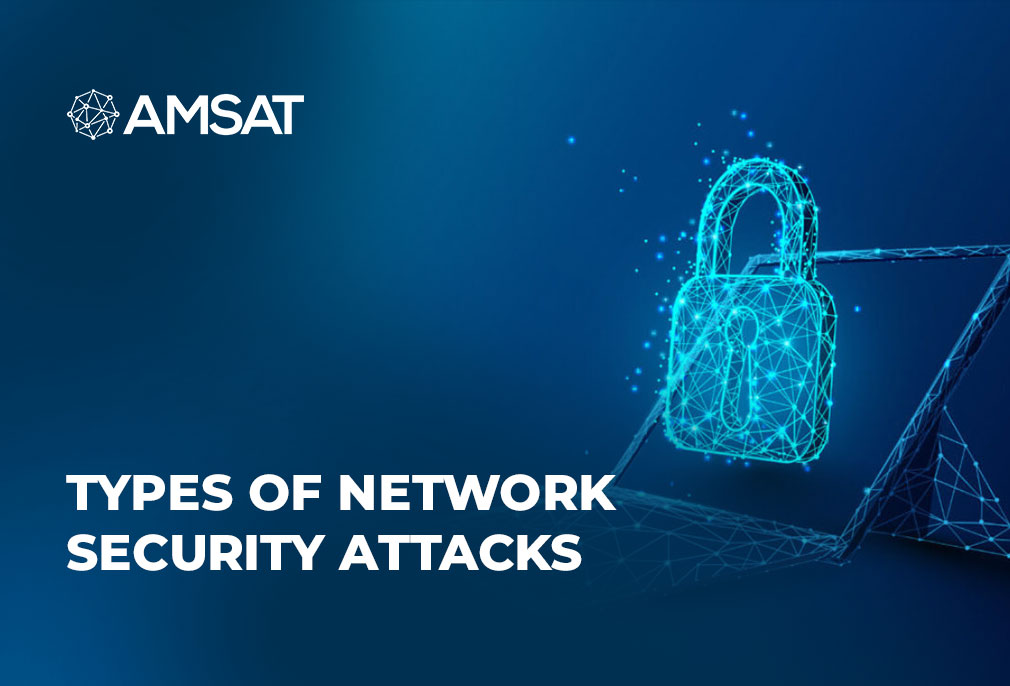Latest Blogs

By AMSAT June 01,2021
Network Security Attacks and Their Types
Internet is one of the greatest sources of livelihoods for millions of people around the globe, as they rely on it for various professional, social, and personal activities. The communication, sharing of data, business transactions, or in short, the entire trade and commerce industry is dependent on the network. Though the internet can network and connect the world-at-large, some people may attempt to damage and disrupt these networks repeatedly for various reasons. These attackers violate privacy and intrude the internet-connected devices either to retrieve information or to make it inoperable.
In the wake of a variety of existing frequent network attacks and the threat of new destructive future attacks, network security has gained prominence in the scope of computer networking.
Common Types of Networking Attacks
1. Virus
A virus needs the user’s communication to infect a computer and spread across the network. An instance is an email with a suspicious link or malicious attachment. When a recipient opens the attachment or clicks the link, the suspicious code gets triggered and avoids the systems security controls and makes them unworkable. In this case, the user unintentionally corrupts the device.
2. Malware
This is one of the most critical cyberattacks that is explicitly intended to destroy or gain unlawful access over a targeted computer system. When malware infects a specific system, it enters the internet and then affects all the systems linked to the internet in the network. An outside endpoint device, if linked, also get infected, working remarkably quicker than other types of malicious content.
3. Worm
A worm can enter a device without the user’s help. When a user runs a susceptible network application, a hacker on the same internet connection can send malware to that application. The application may agree to take the malware from the internet and implement it, thus creating a worm.
4. Phishing
This is the most common type of network attack. Phishing stands for sending emails claiming as from known resources or bankers and generating a sense of urgency to stimulate user to act on it. The email may contain suspicious link or attachment or may ask to share private information.
5. Botnet
In botnet the attacker controls all the computers on the network without the owner’s information. Each computer on the network is considered as zombies as they are aimed at spreading and infecting several devices or as directed by the attacker.
6. DoS (Denial of Service)
A DoS is a vital attack that terminates, completely or partially, a victim’s network or the complete IT setup to make it inaccessible to the genuine users. The DoS attacks can be pigeonholed in three parts: connection flooding; vulnerability attack; and bandwidth flooding.
7. Distributed Denial of Service (DDoS)
It is a multifaceted version of a DoS attack and is much tougher to spot and protect compared to a DoS attack. In DDoS attack, the attacker uses numerous compromised systems to attack a single DoS attack targeted system.
8. Man-in-the-middle
This attack is someone who stands in between the talk happening between you and the other individual. By being in the middle, the cyber-attacker captures, oversees, and controls your communication efficiently. For instance, when the lower layer of the network sends information, the computers in the layer may not be able to find out the recipient with which they are trading information.
9. Packet Sniffer
When a passive recipient located in the terrain of the wireless transmitter, it registers a copy of every packet transmitted. These packets can hold private information, sensitive and critical data, trade secrets, etc., which when hovered over a packet receiver will get through it. The packet receiver will then operate as a packet sniffer, snuffling all the transported packets entering the range. The best protection against packet sniffer is cryptography.
10. DNS Spoofing
It is about affecting a computer by debasing domain name system (DNS) data and then presenting in the resolver’s cache, causing the name server to return an inappropriate IP address.
11. IP Spoofing
It is the procedure of inserting packets in the internet using an incorrect source address and is one of the ways to ploy as another user. An end-point verification that ensures the inevitability of a message originating from the place we found would help protect from IP spoofing.
12. Compromised Key
In this type of attack, a threat actor gains unlawful access to a secured communication using a compromised key, a secret number or code vital to interpret key information without any intimation to the sender or receiver. When the key is gained by the attacker, it is mentioned as a compromised key which serves as a means to retrieve information.
In a Nutshell
Managed network security provides a major revenue opportunity for solution providers and can offer respite for clients that may not have the knowhow or resources to take on the crucial network defense tasks. We live in an era where technology is always changing and cyber threats are becoming harder to spot. Whether you’re in the cloud, the data center, or both, AMSAT’s network security solutions streamline your security without affecting network performance, provide an integrated approach for efficient operations, and enable you to scale for sustained business growth.
TAGS
- Managed Network Secuirty
- Network Security Solutions
- Network Security Firewalls
Recent Blogs
Ready to Get Started?
Our specialists are ready to tailor our security service solutions to fit the needs of your organization.









